SANITY AND SANITIZATION. 5 tragic years of construction in Riga.
Are cities a mirror of the ripeness of our civilisation? Are the urban developers, private or public, at all times responsible before the people? Last 5 years have been the worst in Riga for those willing to find answers on these questions, while caring urban values, wanting to keep the city green, and demanding transparent and noble construction. Here is my collection of visual flashbacks and all the "tragic" incidents and scandals to contemplate on answers.
I think the breaking point was the last 30 days. Probably ones of the most intense in the history of construction in Riga in 100 years or so when it is impossible to stand by and just observe. One scandal and destruction has followed another scandal and destruction. Maybe it’s because the economy is back, so is the ego drive to build or rebuild everything we see. Maybe it’s the previous 10 years of negligence and misconduct at the city level. Maybe it’s the evolving community willing to see a sustainable, honest, natural, and reliable urbanisation. Whatever it is, it has stirred up some emotions recently.
The society is polarized more than ever today. Some want to make room for anything contemporary to come in place, some want to keep the shrinking heritage of modernism and suburbs. Some want a concert hall, some want a green city, the Board of Cultural Heritage insists it is important to protect astonishing values until some degree, many believe the board is not protecting enough, especially any urban heritage created after WWII.
Many have finally understood architecture and urban environment is not about volume and politic schemes any more. It’s about society, well-being, sustainability, collective memory. It’s about a city that thinks about the future without forgetting the past. Many, but not everyone.
There is a saying - don't feed a dog enough for its first year, and the dog will only think about food the rest of its life. Seems that such an angle is what defines many of civil servants running this city/country now; lots of them represent a generation becoming adults during perestroika and the wild nineties.I was born when the USSR was still alive (not sure if kicking). And, just for a moment, I got the taste of everything decent missing in the 90s. I understand in its entirety the feeling when nothing you would like is around, but I can only imagine the cultural, social, political, and even economical struggle the today's politicians faced when growing up during the late Soviet Union. Without a liberty to buy what you desire, live and travel where you want to, follow your own political ideals, or be interested in any hobby or subculture you feel belonging to.
30 years have passed, many have grown old physically and mentally. And when some shit hits the fan, the rest of society feels like we need to pay for their trauma or resentment. Like we, the younger or creative, or risking part of the country need to suffer and suffocate because someone, like a hungry hound, is only interested in sanitizing the past, projecting some inner demons on us, or getting rid of the collective memory in the era of upcycling.
Such are thoughts many, including me, shared when the scandal of the World Trade Centre burst. Built in 1974 as the former headquarters of the Communist Party of Latvia's Central Commitee, it was suddenly listed by the Ministry of Culture for dismantling in order to build the long awaited acoustic concert hall. Without any public discussion, despite every stakeholder, except the Ministry of Culture itself, being in doubts.
The Minister of Culture, Nauris Puntulis, called the house a “Communism spectre” we need to get rid of. It might be true that part of Latvian struggle to be independent was smothered in the cabinets of the building (now been an office space for decades). However, even those deeply related to the restoration of Latvia’s independence from the Soviet Union (for example, Dainis Īvāns) claim that the destruction of the building will also be a destruction of the place where the last secretary of the Latvian Communist Party, Alfrēds Rubiks, was arrested.
 |
| "To tear down, not to construct" (in Russian) - Ministry of Culture (© Verners Timoško) |
But it took 5 long and painful years to get down to such meta levels of architecture and urban critics in Riga. From the first “notable” and infamous degenerated construction works to multi-layered public demands. To reveal the past, I collected almost two dozen cases of "urban abnormalities" and created a visual journey through time to explain - why do I even care contemplating on this?
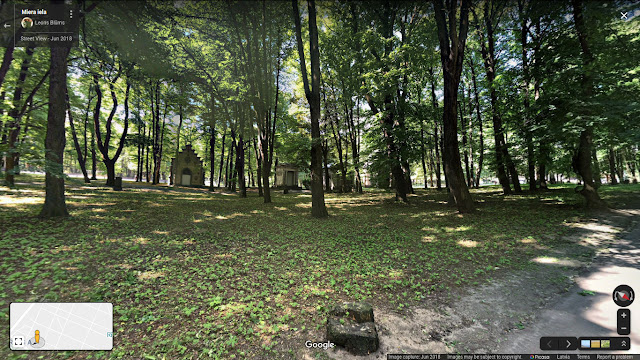 |
| In 2016, a wave of protests and civic activism stopped a large construction of the so called "Cemetery tram", when the City council, without much of discussion, wanted to cut a new tram line along with a magisterial street through the Great Cemetery of Riga. Shortly after, the public discovered the project being a part of the EU Cohesion fund application riddled with discrepancies and, most likely used fraudulently if granted (as usual in Riga then). The project was eventually ceased by the grantor, and a row of corruption scandals shook the city council soon after in 2018. Read more about the cemetery here! |
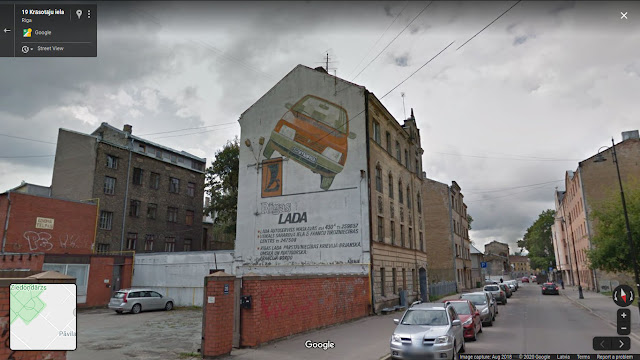 |
| In the summer of 2017, many began questioning the work of the National Board of Cultural Heritage. When the city’s construction authority wanted to punish the owners of this building claiming that this well preserved Soviet ad from the mid-80s is unsanctioned, a fuss began in the social media. Most of people demanded this add of a company not existing for more than 15 years to be preserved as a unique urban gem. Instead, National Board of Cultural Heritage declared the advertisement not even close to a historical heritage (despite it being one of the only Soviet ads left). The city’s construction authority dropped their charges soon after, the mural is saved, but not protected - the owners can cover it any time if wanted. Read more on this clamour here! |
 |
| About the same time as Aurora, Riga City council announced the reconstruction of Āgenskalns market. On the one hand, good news! On the other, the city and the management gave vendors no other alternative to continue their work, many feared the market would open its doors as something else and unsanctioned after the job is done. Eventually, it came to light that the management had not cared about the organisation of the market as well as its emergency condition. Thankfully, activists came in time to boycott the closing and secretive tender for the next managers. A public one was announced, and in May 2018 a new master of the market from the renowned Kalnciems Quarter was assigned. Read more of the market here! |
 |
| Before the food court of Riga Central Market was opened in February 2019, the bakery-related pavilion looked like this. Not pleasant, is it? Although furnished with august purposes to change for the better, the Gastrotirgus food court was criticized immediately after its "influencer" opening - fake diversity of eateries created by one company, lack of integrated local recipes or typical meals, overpriced offer, lack of representation of local community and culture, overly tight space, no recycling policies, and even average, cheap quality materials used in the construction. The food court would soon become a symbol of the non-transparent management of the market. A year later, it was closed due to multiple financial and political reasons and is still empty. Read more of this and other markets here! |
 |
| The Deglava bridge has been a hot potato in Riga for several years already, when its reconstruction plans came to light without considering cyclists and maintaining it as a magisterial road for motorized vehicles. In spring 2019 the bridge was suddenly closed during the reconstruction - despite the city council denying it, the viaduct had had a critically dangerous and dilapidated status for a while already. Since the motorized traffic was forbidden, activists instead used the lockdown for public activities, welcoming people to have a stroll or ride across the bridge, organize a picnic, or micro events. The campaign became viral and continued to open the eyes to those believing the Riga City Council Traffic Department is a transparent, uncorrupted, and responsible establishment. Have a look of one of the "picnic days" here! |
 |
| In November 2019 an ongoing saga began, when the owner of the land once being a known "Marss" velodrome,"State Real Estate", announced the space will be used to build a state office space. Activists and neighbourhood associations soon launched a petition to stop its 100-year-old trees from being cut since no other potential park is around the neighbourhood. After collecting 15,000 signatures and submitting the petition to the parliament, it came to light the lot is already destined to be freed for the new headquarters of State Security Service. A ping-pong between the community and state continues until today; although official commissions have denied the creation of the park, and National Board of Cultural Heritage assigns no status, activists keep on unearthing loads of historic material of this, possibly last evidence of the legendary cycling years in Latvia. Read more on the Marsa park saga here! |
No wonder the residents are so edgy in Riga. If your city had a legacy of such misconduct of construction, planning, and demolition in the last 5 years alone, you would be neurotic urban hypochondriacs too! It’s roughly a construction crisis every 3rd month for 5 years in a row.
When contemplating on the heritage of creativity (seminally, of literature), the philosopher Roland Barthes coined a term "zero position". He claimed that the status, value, meaning, or purpose of everything we create is immediately a subject of the needs of every new era.
Many ask - why some are interested in protecting the Marsa park only now? Why are the architects and urbanists of today confronting the Minister of Culture himself when resisting to demolition of the World Trade Centre / Central Committee, and ignoring the decisions of experts at the National Board of Cultural Heritage? Where were the activists 15 years ago?
I believe (and everyone will agree hopefully) a democratic society is constantly evolving, and what might be useless to some of us, might be already valuable to the ones coming next. Or vice versa. Only in recent years, many have learned the hard lesson of what happens if we ignore our known and unknown heritage, and what satisfaction it brings when something ignored yet astonishing surfaces and comes back to light. We have learned to alter the "zero position" for good.
The reason why the contemporary citizen is so much into a lost cycling track or in suburban markets in the era of shopping centres, is the evolved ability to care of our heritage and the need to live in a country where it does not lie to you. The society has learned to keep what's ours and tell the story even if it hurts. Otherwise - how could we learn from anything we cannot remember? And since when caring of the past is something bad?
Only now much of our positive historical legacy has become a routine again. For example, 15 years ago one would be a weirdo to ride a bike on daily basis, but now it is a daily necessity like it was back in the interwar era. With such a need comes the urge to understand where it all started and why we lost it. Similarly with the markets, urban modernism, or irrational soviet murals - the reason to indulge into something seemingly marginal is never a reason to hurt anyone. It's the opposite, to thank and cherish, and preserve.
The problem here is that many in the country think that the number of protected urban elements in Riga is larger than assumed. Many believe that the World Trade Centre has been a part of the heritage list for a while already. After all, why a unique, nowhere-else-in-the-country-seen, and visually stunning building wouldn't be!
What saddens many is indeed the demand for trust and the lack of it when speaking about the construction and development processes in the city; also their protection. After all, even if built on private grounds, any house becomes a part of the public space we all use and pass by. More than ever, residents demand transparency, honesty, responsibility; something we were missing for long years during and right after the soviet occupation.
On the contrary, some folks believe that the level of activism and “wokeness” of urbanity is ridiculous and, at most cases, overrated. It seems that people protest and rant because they have nothing else to do. Whereas the National Board of Cultural Heritage is slightly irritated by the fact that every single construction or deconstruction case is now pushed through them in order to receive a positive resolution that the subject of interest is indeed a protected heritage.
However these are the rights of residents to demand revising and broadening the national canon of urban heritage since many gems only begin to surface now. Some of them have faced the tides of time, and we start seeing many urban elements as historical and get inspired only by now. And it’s our right as a democratic community to do so.
As prescribes the Faro convention on the Value of Cultural Heritage for Society (2005; also ratified by Latvia), - when the community points out a subject of interest as valuable and preservable, experts must pay attention and evaluate the subject according to both the needs of the society and its owners.The Convention encourages us to recognize that objects and places are not, in themselves, what is important about cultural heritage. They are important because of the meanings and uses that people attach to them and the values they represent.
Surely, some places might not seem a value to most of the community; or some famous names. In fact they might be against them to the full. Still the story of what we have because of places is something the next generation might value more than us.
For example, I am one of those mad, maybe handful of people, who strongly reject the idea of destroying the Memorial of Victory over the Nazi forces in Latvia. For a long time, I could not put my thoughts in words why until recently an activist, when responding to the liquidation of colonialist and slave trader monuments during #BlackLivesMatter, claimed that - by destroying such artefacts we also destroy some of the evidence of the wrongdoing. She claimed that, instead of this annihilation, we must de-contextualize.
 |
| In front of the monument at Uzvaras park (2019). |
And it is utterly true. How many of the future generations will be able to understand the atrocious soviet reign and what this "victory" actually brought to the country? Will the memories matter in 20 years for the kids of tomorrow if no tangible artefacts of this savage era in Latvian history are present? How long can we, in a contemporary country, remember constructs existing only as abstract ideas and memories?
When writing about the Victory park last year, we shared our experience when running tours around the area. We had a pun among the guides that, if the monument were to be destroyed, there wouldn't be a good place to stop for a story. Therefore, instead of destroying such artefacts, can't we really channel their story? Indeed, de-contextualize their existence?As much as I know, there is a massive underground space below the memorial. Instead of clearing the whole ensemble, we can spend just a bit more effort to furnish the underground space with stories the monument really represents to Latvians, and tell the stories to others to comprehend.
However, I am not claiming that nothing built or established should be destroyed. It's the scale and alienation within the ensemble, not only the political weight.
One great (terrible) example was the Riga Technical University's laboratory house built in the 1960s; right in the middle of Old Town. Despite (probably) it being a rational establishment and a well built house, it was a monster when speaking of scale, materials, unity of historical and architectonic belonging. In this case, the house was so out of any context, there was nothing left to de-contextualize.
 |
| One half of the laboratory house as left before .deconstruction (Raitis Puriņš; 2009). |
I believe that, when talking about urban environment, we cannot only see it as for today anymore. We have encountered generations only fulfilling their present needs, forgetting that many things in the past have helped us to become who we are; so are we helping to establish the future of the ones comming next.
I think the future is going to be exciting in Riga. But I don't believe anyone will be glad learning that it were doing much better, if not the city's policy- and decision-makers, builders and planners, preservers and also users being corrupt, sloppy, sketchy, egoistic, shortsighted, and unproffesional. Maybe some of them call this time the great sanitization for the great future. But one needs to be sane and at full wisdom in order to kill germs and weeds instead of confusing them for thorny, yet roses.
Mārtiņš Eņģelis
editor-in-chief


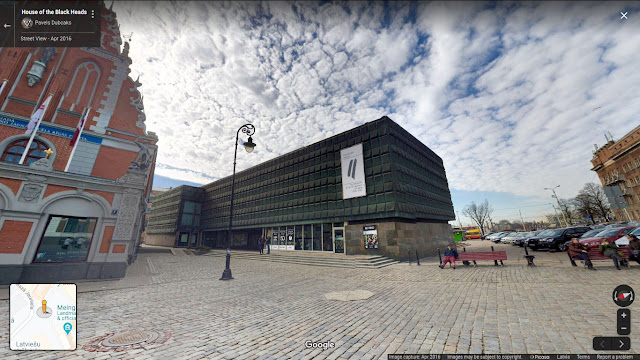







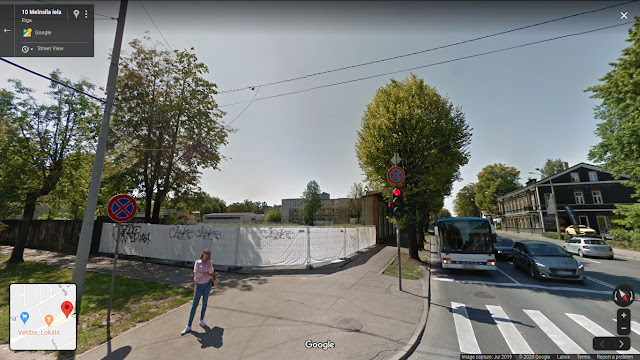



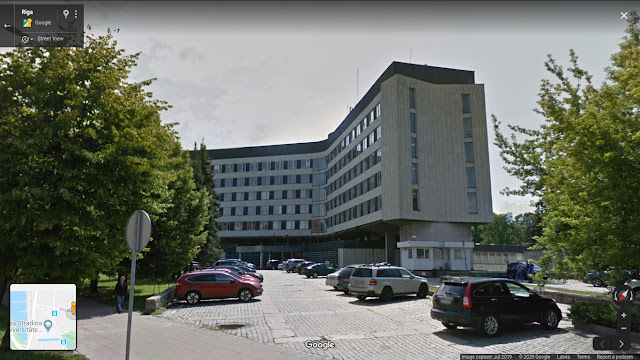

Pilnīgi piekrītu rakstītajam.
ReplyDeleteVēl arī šo var pieminēt: https://latboots.wordpress.com/2017/03/04/planveida-vestures-iznicinasana-babelisa-ezera-elektrostacija/
Jā, pareizi!
Delete